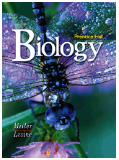BIOLOGY
by Miller & Levine
[complete Table of Contents]

|
Use the pull-down menu to jump to any of the Book's 40 Chapters: |
Additional Resources:
"Timing
is Everything"
An essay on
the NOVA website by Joe Levine, coauthor of BIOLOGY)
Visit
the Darwin Exhibit
at the American Museum of Natural History
(Educator's
Guide to the Exhibit)
What is a Theory? (Video from the Darwin Exhibit - featuring author Ken Miller) Requires RealPlayer.
![]() Chapter 15
Chapter 15 ![]()
Darwin's Theory of Evolution
In this chapter, students will read about how Darwin developed his theory of evolution and some of the evidence that supports this theory. The links below lead to additional resources to help you with this chapter. These include Hot Links to Web sites related to the topics in this chapter, the Take It to the Net activities referred to in your textbook, a Self-Test you can use to test your knowledge of this chapter, and Teaching Links that instructors may find useful for their students.
| Hot Links | |
| Take it to the Net | Teaching Links |
What are Web Codes? |
Web
Codes for Chapter 15: Science News: Evolution • SciLinks: Evolution • SciLinks: Darwin • SciLinks: Natural Selection • Self-Test |
![]()
Section
15-1: The Puzzle of Life's Diversity
![]() During his travels,
Charles Darwin made numerous observations and collected evidence that
led him to propose a revolutionary hypothesis about the way life changes
over time.
During his travels,
Charles Darwin made numerous observations and collected evidence that
led him to propose a revolutionary hypothesis about the way life changes
over time.
 Darwin observed that the characteristics
of many animals and plants varied noticeably among the different islands
of the Galápagos.
Darwin observed that the characteristics
of many animals and plants varied noticeably among the different islands
of the Galápagos.
Section
15-2: Ideas That Shaped Darwin's Thinking
 Hutton and Lyell helped scientists realize
that Earth is many millions of years old, and the processes that changed
Earth in the past are the same processes that operate in the present.
Hutton and Lyell helped scientists realize
that Earth is many millions of years old, and the processes that changed
Earth in the past are the same processes that operate in the present.
 Lamarck proposed that by selective use
or disuse of organs, organisms acquired or lost certain traits during
their lifetime. These traits could then be passed on to their offspring.
Over time, this process led to change in a species.
Lamarck proposed that by selective use
or disuse of organs, organisms acquired or lost certain traits during
their lifetime. These traits could then be passed on to their offspring.
Over time, this process led to change in a species.
 Malthus reasoned that if the human population
continued to grow unchecked, sooner or later there would be insufficient
living space and food for everyone.
Malthus reasoned that if the human population
continued to grow unchecked, sooner or later there would be insufficient
living space and food for everyone.
Section
15-3: Darwin Presents His Case
 In artificial selection, nature provides
the variation among different organisms, and humans select those variations
that they find useful.
In artificial selection, nature provides
the variation among different organisms, and humans select those variations
that they find useful.
 Over time, natural selection results
in changes in the inherited characteristics of a population. These changes
increase a species' fitness in its environment.
Over time, natural selection results
in changes in the inherited characteristics of a population. These changes
increase a species' fitness in its environment.
 Darwin argued that living things have
been evolving on Earth for millions of years. Evidence for this process
could be found in the fossil record, the geographical distribution of
living species, homologous structures of living organisms, and similarities
in early development.
Darwin argued that living things have
been evolving on Earth for millions of years. Evidence for this process
could be found in the fossil record, the geographical distribution of
living species, homologous structures of living organisms, and similarities
in early development.
